
Highland Airways - Later Airmails
Highland Airways. First acceptance at Thurso. 10th December 1934
On the 10th December 1934, the post office planned for airmail sent to Wick to be accepted at Thurso. The mail would be forwarded by train or omnibus. On December 10th mail from Inverness was flown to Wick successfully and transferred on to Thurso. On the return journey from Kirkwall the weather had deteriorated, and a landing could not be made at Wick and was flown onto Inverness. The mail for Wick and Thurso was unloaded at Inverness but due to mishandling of the Thurso mail bag it was not sent back to Thurso until the 12th.First accelerated service from the Shetlands. 25 Mar 1935.
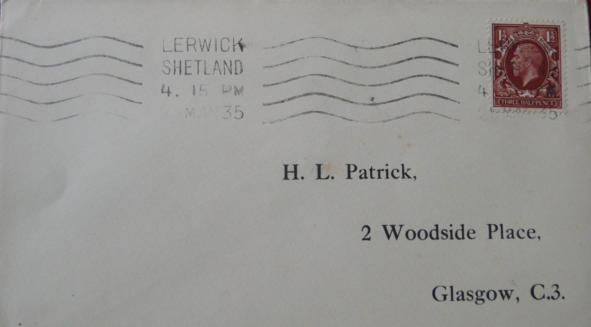
25 Mar 1935. Cover flown on the first
accelerated service from the Shetlands. A
twice weekly service on Mondays and
Wednesdays went by sea from Lerwick
(Mondays) and Scalloway (Wednesdays)
to Kirkwall where the mail was flown to
Inverness in time to catch the 15.45 train
to Glasgow. This was first British air route
using Steamer, Rail and Air. The service
finished when Allied got the Shetland
mail contract. Sent from Lerwick to
Glasgow.
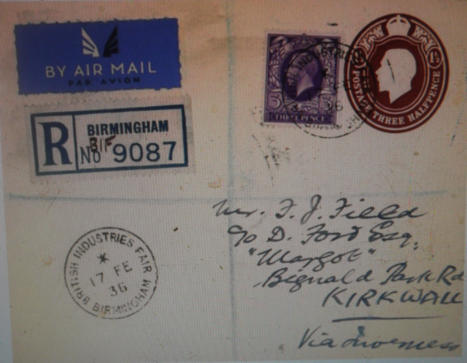
BIF Birmingham mail to Kirkwall. 17th February 1936.
17
th
Feb 1936. BIF Birmingham envelope to
Kirkwall. It would have been railed from
Birmingham to Inverness where it would have
been flown to Kirkwall. BIF cancel with date.
Stronsay Emergency Flight. 27th January 1937.
There was an emergency flight from Sanday on the 23rd December 1936, but no mail is thought to have survived. The first emergency flight where examples of flown mail are in existence are the Stronsay Emergency flight of the 27th January 1937. Pilot Adam Smith conveyed mail from Stronsay to Kirkwall and Kirkwall to Stronsay. Foodstuffs were then carried to North Ronaldsay, but no mail was carried on the flight.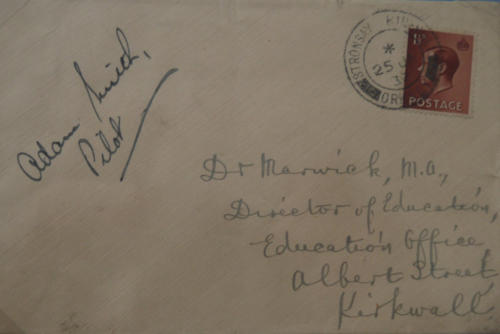
Commercial cover to the Director of Education at
Kirkwall. Endorsed by the pilot Adam Smith, who
endured appalling conditions (75Mph winds) to
complete the journey.
Second Sanday Emergency flight. 28th January 1937.
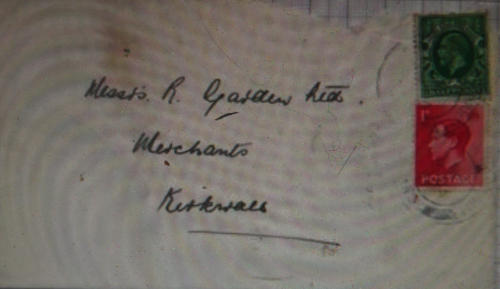
28 Jan 1937. 2
nd
Emergency flight from Sanday.
Posted at Sanday on the 25
th
January. It was flown
by Ted Fresson to Kirkwall. He also called at Rousay
and Westray.
First Unofficial Flight to Fair Isle. 13th May 1937
13th May 1937. Coronation day. Fresson flew to Fair Isle with a passenger Alexander ‘Sandy’ MacLaren. a local photographer, to drop off some souvenir newspapers. A plane had never landed on Fair Isle before but Fresson had seen a possible landing spot on a flight to the Shetlands. Fresson describes the trouble in landing when caught in a ‘sinker’ in his autobiography ‘Air Road to the Isles’, but they landed successfully on the second attempt. The whole Island turned up to see them land, some of whom had never seen a plane close up before. They were greeted by ‘old Mr Stout’, the local postmaster, who invited them to the Island’s Coronation tea party.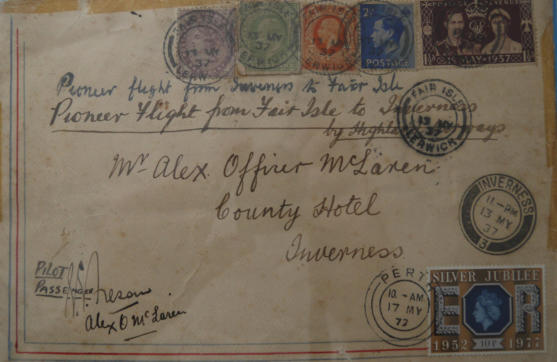
This souvenir envelope is one of two items
that were flown that day. The envelope has
a mixed reign combination and is stamped
at both Inverness and Fair Isle. Signed by
the pilot Ted Fresson and his passenger
Sandy Maclaren.
Second unofficial air mail Fair Isle to Lerwick. 24 December 1937.
Second unofficial air mail Fair Isle to Lerwick. A round trip that is both Lerwick and Fair Isle cancelled. Signed pilot J. A. Hankins. He dressed as Santa Claus and carried presents for all the Islands 17 children. There are two types of envelope. a) The three-line red cachet is closely spaced b) The three-line red cachet is widely spaced.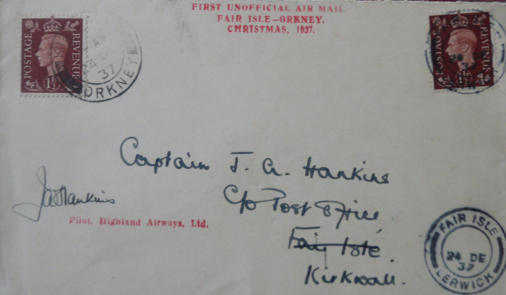

as
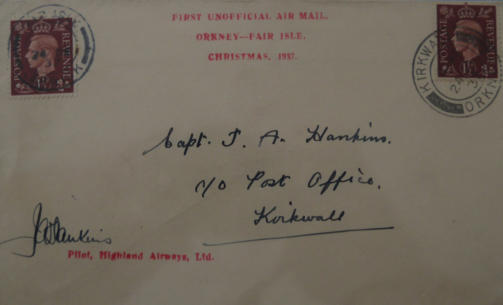
First type with the three-line cachet tightly spaced.
Stamped at Kirkwall and Fair Isle on this round trip.
Signed by the pilot, Hankins.
Photo of Hankins dressed as Father Christmas
delivering mail and ballons to the children
Second type of the envelope where the 3 line red
cachet is more widely spaced. Cancelled at Fair Isle
and Kirkwall on the round trip. Signed by pilot
Hankins.
Final flight of Highland Airways. 2nd May 1938.
Despite being merged with United Airways in 1935 and later with British Airways, the airline had managed to keep its identity. This changed on 3rd May 1938 when Highland merged with George Nicholson’s Northern and Scottish Airways to form Scottish Airways.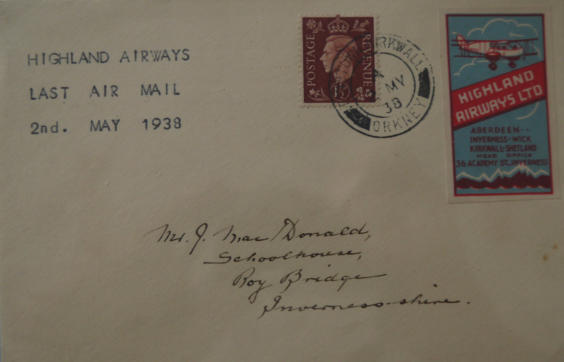
Final flight envelope with Highland AIrways
three-line cachet in black. Cancelled at
Kirkwall and sent to Inverness. The less
usual general-purpose vignette is also
present.
Emergency flight to Stornoway 4th March 1938
On this date mail for the Isle of Lewis was held up by heavy seas at Kyle (Ross and Cromarty). It was therefore recalled to Inverness and was flown to Stornoway on behalf of the post office by Highland Airways. Ted Fresson carried forty bags of mail on the outward service and there was no return mail. Flown covers are rare and I do not have an example to show.
Copyright
© 2022 Robert Farquharson All Rights Reserved


British Internal Airmails of the 1930’s
The route up to Thurso from Inverness had no problems and mail sent in that direction was delivered that day. The example below is sent post
restante, so it has a backstamp. It is sent on a Caithness Souvenir cover which was used on the first day of the Wick extension on the 1st December
1934.
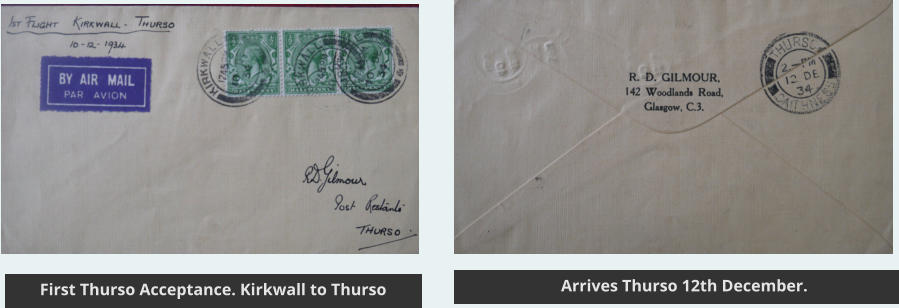
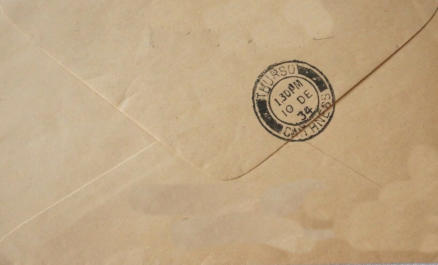
First Thurso Acceptance. Inverness to Thurso.
Arrives Thurso 10th December.
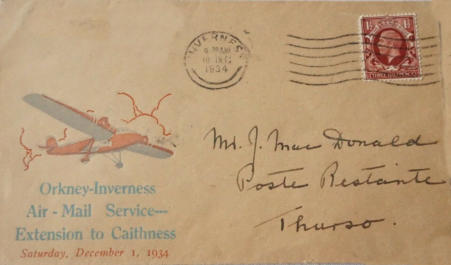
Photo of Hankins dressed as Father Christmas
delivering mail and ballons to the children
Second type of the envelope where the 3 line red
cachet is more widely spaced. Cancelled at Fair Isle
and Kirkwall on the round trip. Signed by pilot
Hankins.
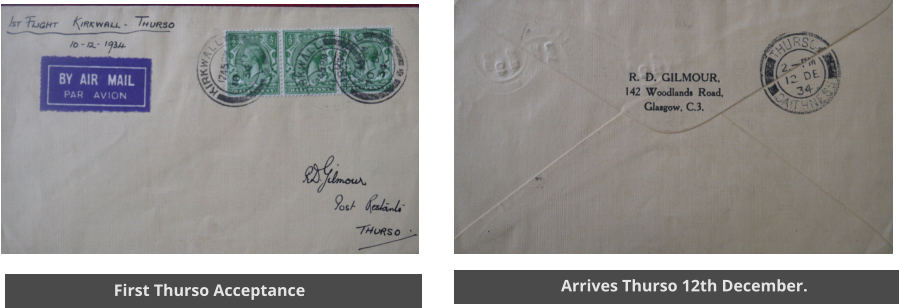
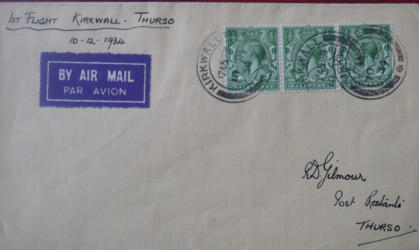
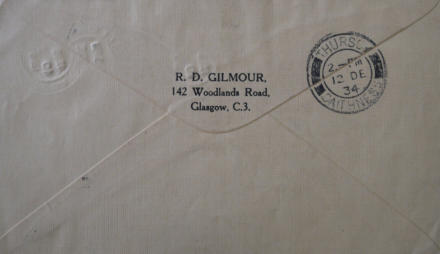
First Thurso Acceptance. Kirkwall to Thurso
Arrives Thurso 12th December.

Highland Airways - Later Airmails
Highland Airways. First acceptance at Thurso. 10th December 1934
On the 10th December 1934, the post office planned for airmail sent to Wick to be accepted at Thurso. The mail would be forwarded by train or omnibus. On December 10th mail from Inverness was flown to Wick successfully and transferred on to Thurso. On the return journey from Kirkwall the weather had deteriorated, and a landing could not be made at Wick and was flown onto Inverness. The mail for Wick and Thurso was unloaded at Inverness but due to mishandling of the Thurso mail bag it was not sent back to Thurso until the 12th.First accelerated service from the Shetlands. 25 Mar 1935.


BIF Birmingham mail to Kirkwall. 17th February 1936.
Stronsay Emergency Flight. 27th January 1937.
There was an emergency flight from Sanday on the 23rd December 1936, but no mail is thought to have survived. The first emergency flight where examples of flown mail are in existence are the Stronsay Emergency flight of the 27th January 1937. Pilot Adam Smith conveyed mail from Stronsay to Kirkwall and Kirkwall to Stronsay. Foodstuffs were then carried to North Ronaldsay, but no mail was carried on the flight.
Second Sanday Emergency flight. 28th January 1937.

First Unofficial Flight to Fair Isle. 13th May 1937
13th May 1937. Coronation day. Fresson flew to Fair Isle with a passenger Alexander ‘Sandy’ MacLaren. a local photographer, to drop off some souvenir newspapers. A plane had never landed on Fair Isle before but Fresson had seen a possible landing spot on a flight to the Shetlands. Fresson describes the trouble in landing when caught in a ‘sinker’ in his autobiography ‘Air Road to the Isles’, but they landed successfully on the second attempt. The whole Island turned up to see them land, some of whom had never seen a plane close up before. They were greeted by ‘old Mr Stout’, the local postmaster, who invited them to the Island’s Coronation tea party.
Second unofficial air mail Fair Isle to Lerwick. 24 December 1937.
Second unofficial air mail Fair Isle to Lerwick. A round trip that is both Lerwick and Fair Isle cancelled. Signed pilot J. A. Hankins. He dressed as Santa Claus and carried presents for all the Islands 17 children. There are two types of envelope. a) The three-line red cachet is closely spaced b) The three-line red cachet is widely spaced.

as

Photo of Hankins dressed as Father Christmas
delivering mail and ballons to the children
Final flight of Highland Airways. 2nd May 1938.
Despite being merged with United Airways in 1935 and later with British Airways, the airline had managed to keep its identity. This changed on 3rd May 1938 when Highland merged with George Nicholson’s Northern and Scottish Airways to form Scottish Airways.
Emergency flight to Stornoway 4th March 1938
On this date mail for the Isle of Lewis was held up by heavy seas at Kyle (Ross and Cromarty). It was therefore recalled to Inverness and was flown to Stornoway on behalf of the post office by Highland Airways. Ted Fresson carried forty bags of mail on the outward service and there was no return mail. Flown covers are rare and I do not have an example to show.
Copyright
© 2020 Robert Farquharson All Rights Reserved


British Internal Airmails of the 1930’s
The route up to Thurso from Inverness had no problems and mail sent in that direction was delivered that day. The example below is sent post
restante, so it has a backstamp. It is sent on a Caithness Souvenir cover which was used on the first day of the Wick extension on the 1st December
1934.
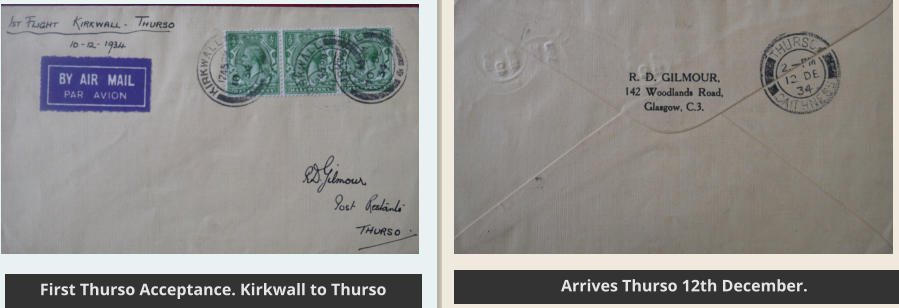
First Thurso Acceptance. Inverness to Thurso.

Photo of Hankins dressed as Father Christmas
delivering mail and ballons to the children


First Thurso Acceptance. Kirkwall to Thurso





























